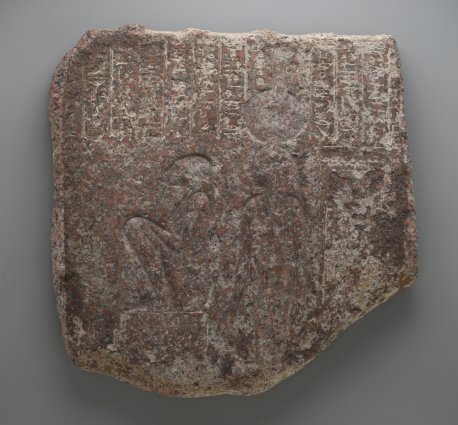Relief Fragment
Overview
Relief Fragment [ edit ]
While magnificent temples decorate the landscape of Upper Egypt, from Abydos to Nubia, only the smallest architectural vestiges remain in the marshy flatlands of the northern Delta. Yet early archaeologists discovered numerous blocks scattered around various sites, whence they eventually migrated to Cairo and other collections around the world. An Egyptologist observed the present relief among such a pile of blocks near Samannûd in 1911. It subsequently moved to the collection of Dikran Kelekian, an Armenian-American dealer living in New York, before ultimately arriving at Yale.
Samannûd (Hieroglyphic: Tjeb-netjer; Greek: Sebennytos) in the central Delta, was the home to the Thirtieth Dynasty, sometimes called “Sebennytic.” It was here that Nectanebo II, Egypt’s last native pharaoh, began construction on a temple for his patron deity Onuris-Shu, to be completed during the early Ptolemaic Period. Today, all that remains of this temple are dozens of scattered blocks, including the present relief.
The feline goddess on the left is (Bubastis), squatting upon a stepped platform. The caption identifies her as “She who is upon her dais, in the throne of Horus,” a specific form of Bastet associated with royal coronation and the ceremonial punishment of rebels. To her right follows Maat, the goddess of cosmic order, wearing a composite solar disk and ostrich plume on her head; she stands before a large naos which the caption identifies as “the unknowable, mysterious shrine.”
While the fragmentary nature of the block prohibits any definitive interpretation of the scene, the presence of the mysterious shrine and textual references to a certain god who would have faced Bastet and Maat (now missing), suggest this relief may come from an Osirian chapel within the temple of Sebennytos.
Period
Dynasty 30 – Early Ptolemaic Period (360 – 246 BCE)
Dimensions
H. 69.85 cm; W. 64.77cm
Provenance
French
Museum
Yale Art Gallery
Accession Number
1954.52.1
Christine Favard-Meeks graciously provided information concerning this object and its provenance.
Campbell Cowan Edgar, “Notes from the Delta, II: The Temple of Samanoud,” Annales du Service des Antiquités de l’Égypte 11 (1911): 95
Jean-Claude Goyon, Le rituel du sHtp xmt au changement de cycle annuel (Bibliothéque d’Études 141; Cairo: Insitut Français d’Archéologie Orientale, 2006), pp. 55-62
Dimitri Meeks, Mythes et légendes du Delta d’aprés le papyrus Brooklyn 47.218.84 (Mémoires de l’Institut Français d’Archéologie Orientale 125; Cairo: Institut Français d’Archéologie Orientale, 2006), pp. 240-241.
Gerry Scott, Ancient Egyptian Art at Yale, p. 192, No. 133.
Neal A. Spencer, “The Epigraphic Survey of Samanud,” The Journal of Egyptian Archaeology 85 (1999): 55-83 (mentioning this block on p. 81, n. 111).
George Steindorff, “Reliefs from the Temples of Sebennytos and Iseion in American Collections,” The Journal of the Walters Art Gallery 7/8 (1944/1945): 57, Fig. 22 (No. 21).
A similar depiction of Bastet occurs in Hibis temple: Norman de Garis Davies, The Temple of Hibis in El Khargeh Oasis, vol. 3 (Publications of the Metropolitan Museum of Art Egyptian Expedition 17; New York: 1953), Pl. 3, register VII (middle).


